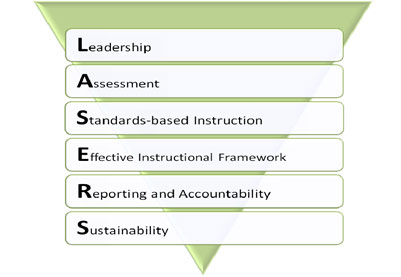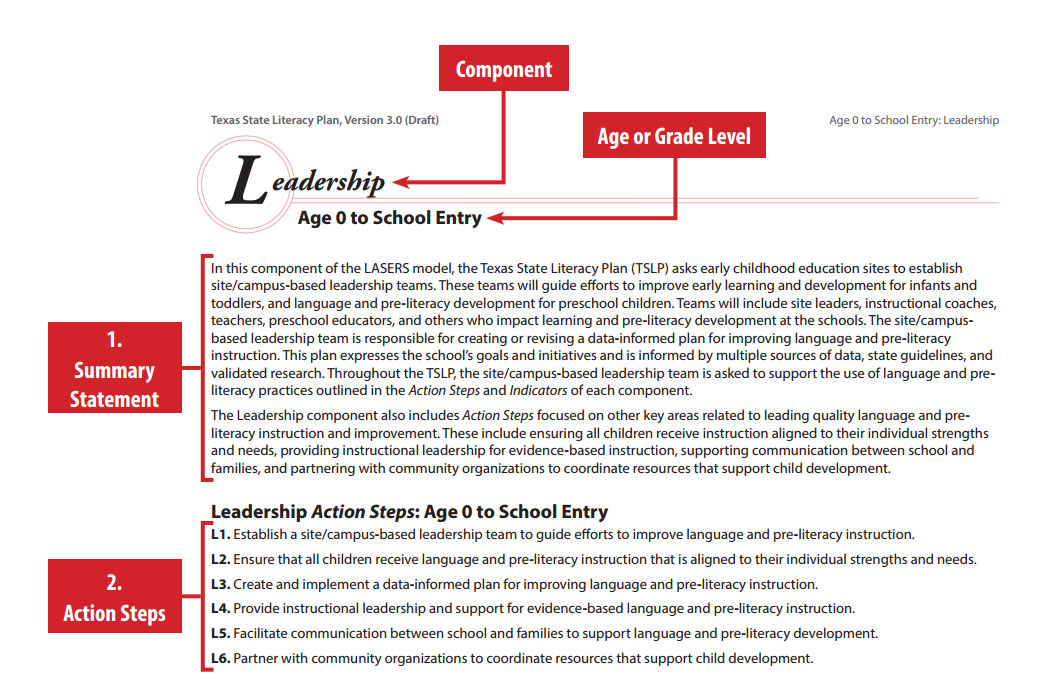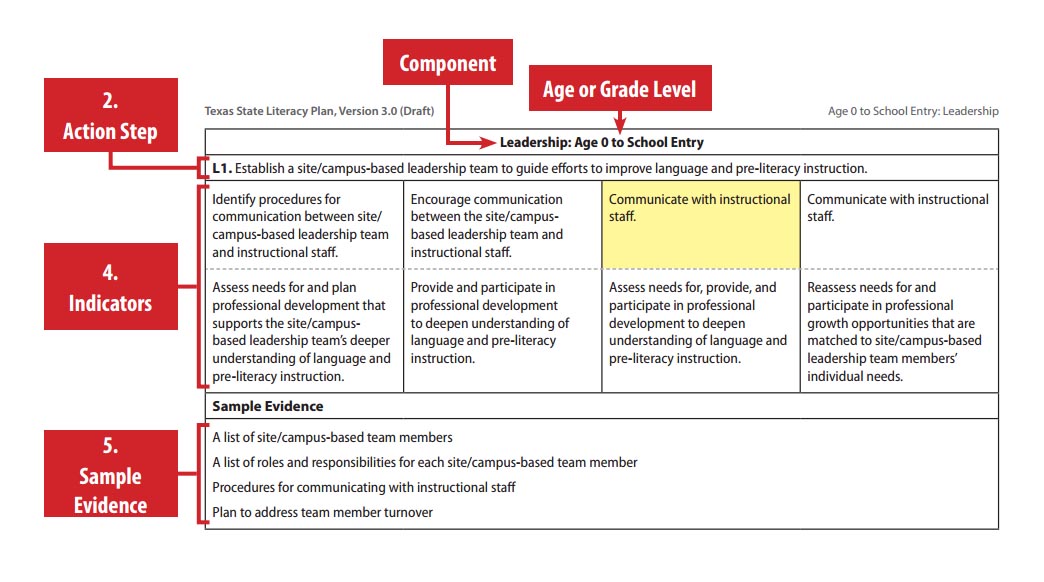Orientation
Welcome to the Texas State Literacy Plan Online Course.
This lesson is designed to provide district and campus leaders with information about and suggestions on the use of the Texas State Literacy Plan (TSLP) online course to support literacy improvement efforts at the site and campus level. This lesson also provides an introduction to the TSLP.
To review the rest of the lesson content, click on the section titles in the left hand margin.
Part 1—Introduction to the Texas State Literacy Plan
The purpose of the Texas State Literacy Plan is to guide school and district leaders in school-wide efforts to improve reading and writing outcomes for students. The TSLP provides a comprehensive description of the practices and systems needed to reach this goal at three age and grade levels—Age 0 to School Entry, Kindergarten through Grade 5, and Grades 6 through 12.
The Plan is organized into a framework of six essential components:

Increasing capacity in these six areas is necessary to ensure the success of the next generation of college- and career-ready Texans.
Each component of the TSLP includes the following:

(Click on the image above to see a larger version.)

(Click on the image above to see a larger version.)

(Click on the image above to see a larger version.)
- Summary Statement: A summary statement for each of the LASERS components is provided at the beginning of the Implementation Guide in each of the age/grade levels.
- Action Steps: Each component of the TSLP is comprised of a set of key Action Steps at each age/grade level grouping. While you will, of course, want to coordinate with state- and district-level actions in support of literacy, the Action Steps in the TSLP can support your implementation at the site or campus level. These Action Steps are numbered but are not meant to be implemented in sequential order.
- Implementation Status Ratings: The Implementation Status Ratings provided for each Action Step are adapted from Fixen, Naoom, Blase, Friedman, & Wallace (2005). In the online course, these are also referred to as implementation levels.
- Implementation Indicators: These Indicators further explain the Action Step by describing what practices and systems are being planned or taking place at the different levels of implementation. Sites and campuses use the Indicators as a guide during self-evaluation and when developing plans of action during implementation of the TSLP Action Steps.
- Sample Evidence: Sample Evidence for the implementation of Action Steps is listed below the Implementation Indicators. The samples might include agendas, sign-in sheets, or lesson plans. Samples are intended to serve as guides and should not be considered an exhaustive list.
You can download a copy of the TSLP here. The three-page guide illustrating the organization is downloadable here.
The TSLP Implementation Guides are also available by age/grade level (without the Introduction, Appendices, and Glossary that are included in the full version).
Part 2—How the TSLP Online Course Might Be Used
The TSLP online course can be used by schools in various ways. Two main ways that it may serve your school or district are
- for building capacity of leaders at the site and campus level.
- for guiding improvement efforts—supporting the prioritizing of focus areas, as well as information and resources specific to priorities once they are identified.
First let’s look at using the course for building capacity. By engaging in the online course, school leaders can learn about evidence-based practices for literacy instruction, response to intervention (RTI), and assessment. They can also learn about planning, leading, evaluating and sustaining improvement efforts.
When using the course for building capacity, schools may decide to begin with the Leadership module. This module guides you in building your site- and campus-based leadership teams, which are an integral element of the TSLP. From there, these teams may engage with the modules in the order of the LASERS components or in order of priority based on their self-assessment of TSLP Implementation (explained in detail in the Introduction lesson). For example, a school may identify the Standards-based Instruction component as an area of need and decide to proceed to this module right after participating in the Leadership module.
Schools may also decide to engage in the modules out of order for other strategic reasons. For example, a school may decide to participate in the brief Sustainability module at the beginning of a limited-time initiative to help them create an action plan that will be successful and enduring, that is, to build in sustainability from the start.
Leaders would benefit from previewing the components of the TSLP and sampling some lessons to decide which approach will best meet the needs of their district or school. In any configuration, it is highly recommended that leadership team members begin the course with the Leadership module, especially Lessons 1–4.
In addition to the five LASERS component modules, you will find an Implementation module, which guides participants in the process of planning, enacting, and evaluating their focused work on an Action Step. The examples in the module show a campus team working on an Action Step from the Effective Instructional Framework component. However, the process described in the module is useful when implementing an Action Step from any component of the TSLP, so the module can be used multiple times, with different areas of focus. Schools might decide to engage with several LASERS modules to build knowledge and then take the Implementation module, or alternate between LASERS modules and the Implementation module.
The TSLP online course can also be used as a point-of-need professional development tool. Using this approach, schools identify their areas of priority with regard to the TSLP and then engage with the module that corresponds to that area. For example, if a school’s self-assessment shows a strong need in the Assessment (A) area of LASERS, the team could follow their Leadership (L) module with the A module. Once team members have strengthened their capacity in that area of need, they might then use the Implementation module to guide their work on a particular Action Step in that component.
To be best prepared to use the TSLP online course successfully, it is recommended that all participants review the Introduction lesson and the Leadership module, at least Lessons 1–3.
Regardless of what starting point or approach to the course you use, it is important to remember that the conversations and learning that come from engaging with the course content may enable teams to see new gaps and needs, leading them to change priorities and adjust action plans when appropriate.
The following scenario shows how one elementary school initiates literacy improvement efforts using the TSLP and its supporting resources, including the TSLP online course.
Scenario: Administrators at Sotomayor Elementary School have among their goals the top priority of improving the delivery of literacy instruction for English learners (ELs) at their campus. Knowing that they will begin work implementing the TSLP in the coming school year, they decide to align their TSLP efforts with this top priority. The principal, instructional administrator, and the campus reading coach decide that the initial step in achieving this goal is to build a campus-based leadership team, which will lead the school’s efforts in the areas of literacy and response to intervention (RTI) for ELs. So, they begin with the Leadership module of the TSLP online course, which guides them in building a strong campus-based leadership team.
Once the campus-based leadership team is formed, its first task is to collaboratively review key student data and identify overall trends in literacy development, with focused attention on the campus’s EL population. At the end of this initial data analysis meeting, the team leader assigns “homework” for members to complete before the next meeting. She asks team members to review the different components of the TSLP with their Action Steps and Indicators, to skim the related lessons in the TSLP online course, and to bring ideas about what lessons and components should be prioritized, based on each member’s expertise and knowledge of the staff’s areas of need. At the next meeting, the team considers these contributions and ideas, along with another key source of information: the school’s self-assessment and Implementation Inventory.
After engaging in thoughtful review of each of these sources of information, the team agrees that most staff either do not have a clear understanding of RTI or misunderstand RTI as a process that only certain specialized staff need to be knowledgeable about. Team members feel that they need to garner a strong foundational knowledge of RTI and be able to better assess the campus’s current RTI model, as well as pinpoint Action Steps needed to ensure a strong RTI foundation is in place. Team members agree that focusing on the Effective Instructional Framework (E) component of the TSLP will help them to address these areas of need.
The team sets a schedule for reviewing the content of the E module of the TSLP online course, meeting to discuss the content, and completing the assignments. As they take the module, team members discuss which Action Steps are potential priorities and stay flexible about what path to take after completing the E module.
For example, one possible path the team could take is to participate in the Implementation module right after the E module. That way, the team would begin focused work on implementing change related to a specific Action Step they learned about. On the other hand, their discussion of RTI might lead them to realize that there are major areas of need in the area of assessment. In this case, the team might decide to complete lessons in the Assessment module before beginning the Implementation module or implementing a specific Action Step.
Part 3—Supporting Effective Site- and Campus-Based Leadership Teams
The TSLP online course is designed to be taken by a team of leaders at a site or campus. Throughout the TSLP and the online course, this team is called the site-based leadership team (Age 0 to School Entry) or campus-based leadership team (Kindergarten through Grade 5, and Grade 6 though 12). This team might be formed for the purpose of using the TSLP and the online course to guide improvement initiatives, or it might be an existing group, such as a site-based team or committee focused on all school improvement efforts that include literacy instruction.
In either case, the team should be comprised of administrators, teachers, and other stakeholders who are informed about and involved in literacy instruction. The most effective teams leverage the knowledge of each member to plan strategic action; it is important that teams include administrators who have the authority to implement these actions.
The first lesson of the Leadership module explains these teams in detail. Before getting started with the teams and the TSLP online course, it is best for leaders (at the campus or district level) to consider the context in which they plan to engage the teams. The TSLP is designed to be a resource that guides the work of educators who endeavor to improve literacy instruction. The online course is designed to help educators understand the components and indicators of the TSLP and to plan how to use these resources in service of their school’s goals. The goal is to improve instruction and literacy outcomes—not to “do” the course or the TSLP for its own sake.
Administrators at Emily D. West Elementary School, with support from their district, identified broad literacy improvement goals based on their student data. The principal presented a summary of the data and the goals to the school staff. She also let the staff know that some of them would be asked to serve on a campus-based leadership team focused on literacy improvement. She gave the team an overview of the resources that they would use to work toward these goals, including the TSLP and the online course.
By setting and communicating goals first, the principal at Emily D. West set up the motivation and urgency for the campus and framed the TSLP and the online course as resources for working toward the school’s established goals. Although not all staff members will be directly involved in using the course, they are all informed of the goals and the expectation that they be working toward them. When campus-based leadership team members share their work on the course, the rest of the staff will be on board. All the staff will be motivated to work with the team to implement the initiatives they develop with guidance from the TSLP and online course.
Set the expectation for targeted improvement based on data.
Then use the TSLP and online course as tools in working toward goals.
Here are some guiding questions to help leaders think about, discuss, and decide how to use the TSLP online course:
What are existing goals related to improvement in literacy outcomes?
What existing systems, committees, or groups that are focused on literacy already exist?
How successful have these groups been in working to address literacy needs?
How can you build on what is working well?
How can you learn from and adjust based on what has not been successful?
How can you leverage existing efforts that are also focused on literacy?
How can the TSLP serve other existing initiatives?
How can you facilitate the integration of the TSLP into current discussions or how can you engage staff in this work?
How can you enhance, align, strengthen, and coordinate efforts to improve literacy instruction by using the TSLP and the online course?
Assignment
Each lesson in the TSLP online course has an assignment for the leadership team to work on together. The assignment is a reflection task, which is the same for most of the LASERS lessons (with the exception of a few lessons in the Assessment 0–SE module). The task is to reflect on the Implementation Level of your site or campus for the Action Step and to identify some next steps you will take when you are ready to focus your improvement efforts on the Action Step.
The assignment is structured this way to guide your team to reflect on what is needed as you discuss the content of each lesson, even though you may not be actively initiating and sustaining work on the Action Step at the time you are learning about it in the course. The assignment allows you to record your best ideas for next steps and refer back to the completed assignment once you decide to work on the Action Step as a school.
The assignment for the Implementation module differs from the assignment for the six LASERS modules described above. The Implementation module includes a planning template to guide your team in developing and enacting an improvement plan using the TSLP; the assignments are the completion of this template, in stages, over the course of the five lessons.
In setting up use of the TSLP online course, you will need to determine how you will manage the assignments. It can be helpful to use the assignments as a form of accountability as well as for professional learning. Before you roll out the course, consider and communicate to participants how and when they will be monitored for course completion. Be sure to address logistical concerns, such as when assignments are due, in what format, to whom, and what the consequence of non-completion will be. This information will help leadership teams stay engaged and make the best use of the assignment reflection tasks.
Remember that the value of the assignments is primarily in the discussions and work needed to complete them, rather than in the completed assignment documents themselves. The systems and expectations you set up will encourage teams to use these assignments as a framework for conversations about the improvement of literacy instruction and the use of the TSLP to support that goal.
Reference
Fixsen, D. L., Naoom, S. F., Blase, K. A., Friedman, R. M., & Wallace, F. (2005). Implementation research: A synthesis of the literature (FMHI Publication 231). Tampa, FL: University of South Florida, Louis de la Parte Florida Mental Health Institute, The National Implementation Research Network.